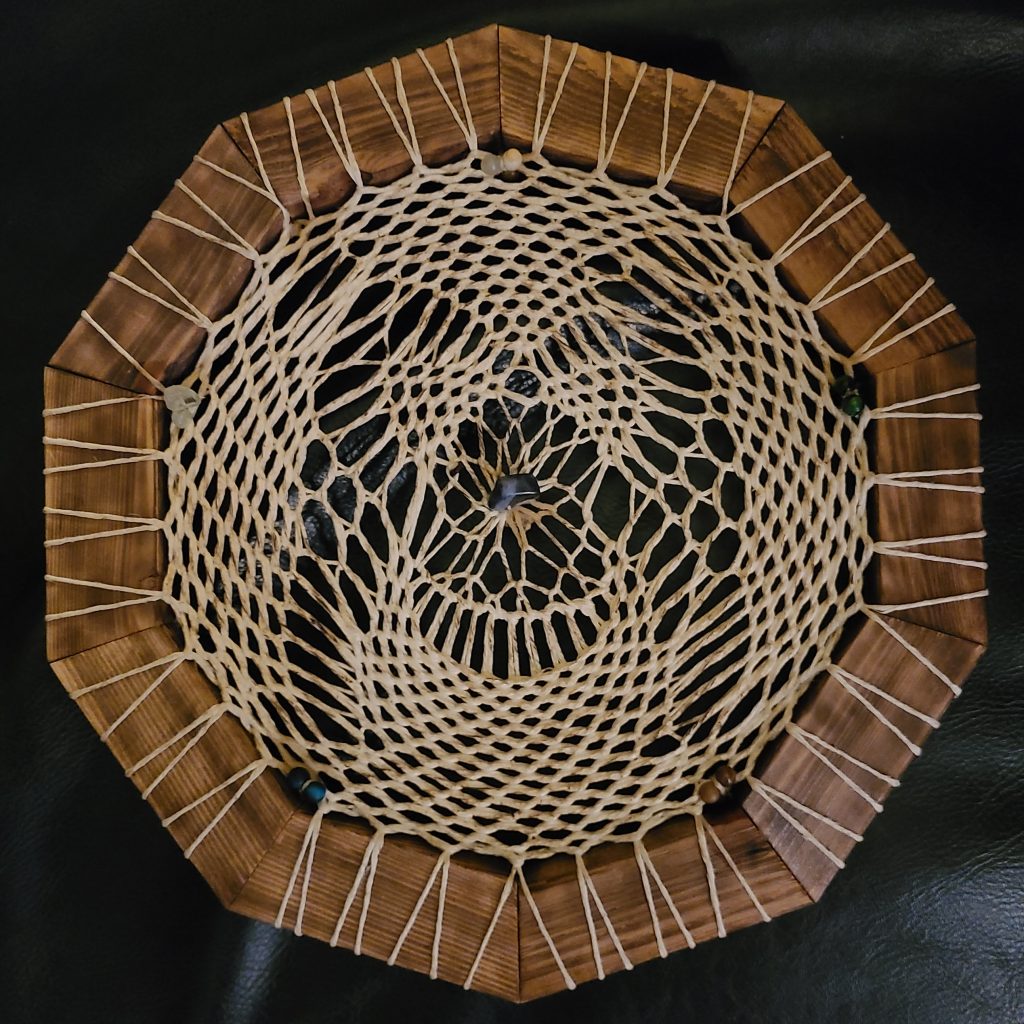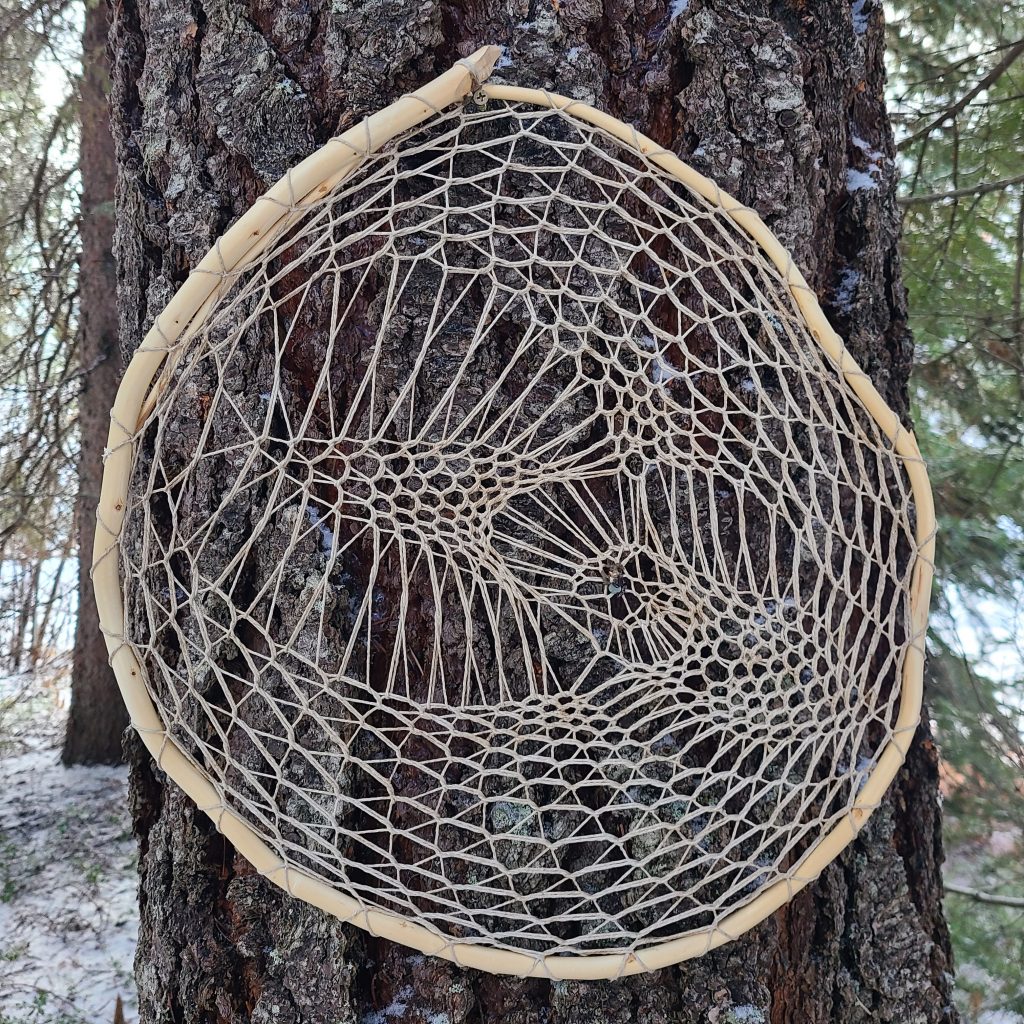This post is part of our Artisan Profiles series, promoting authentic artisans and their products. Artisans: get your store featured by joining our free Buy Handmade campaign. Read the others here.

Meet Brent Joly
Spotting one of Brent Joly’s woven sculptures (BJ Woven) twirling around outdoors is mesmerizing. Extrapolated from traditional dream catchers, these fantastical cedar and hemp pieces look like organically created portals.
Based in Canada, and using foraged material, Brent has been refining and redesigning the work, as he thinks of it, for more than a decade. We took the opportunity to ask him some questions about his journey into this world of wood, string and organic three-dimensionality.
Looking at your dream catchers, portals and sacred geometry come to mind. What inspired you to interpret traditional weaving into 3-D? Did the idea come to you in a dream?
I am ten years deep into making these. The jump to three dimensions just seemed like a logical step to make at the time. What I love about weaving is starting with a one-dimensional string. Weaving that back and forth long enough creates a two-dimensional surface. Wrap that surface around on itself and connect two opposite edges, and you have created a three-dimensional tube. In much the same way our complex bodies are comprised of comparatively simpler cells, these woven sculptures are held together by the tension of a single fiber, tangled in such a way that it transcends its own complexity to appear as a simple object to the viewer. It is harder to implement the coherent patterns you see in the two-dimensional pieces into the three-dimensional ones. Thrones Angels have been a more recent discovery as correlative to the shape of most spherical pieces.

Your weaving and shapes have grown more and more intricate. Do you sketch or use an app to plan the design beforehand?
These things make themselves, and I am merely a conduit for their creation. It is completely meditative. The furthest extent that I would admit to pre-planning would be the formation of the frames, but I have even let that get randomized lately. For the more geometrical shapes like dodecahedra and truncated tetrahedra, I do require the precision of a compound miter saw and careful measurements. Once these frames are assembled though, there are countless ways to weave them. The same shape is never woven in the same way. Every piece must be unique. Simple shapes have limitations, so they tend to be made more swiftly than when full exploratory mode is active. Whenever I am deciding how many surfaces a piece will have, I do need to plan ahead enough to maintain symmetry for each one, but this is always done on the brink of consciousness. In the early days, I would use masking tape and arrows to mark the direction of crochet along the edges of the frame.
Why do you choose to use cedar over willow stems for the structure?
Availability. Cedar was just more available than anything else, and is regarded as a sacred tree in many cultures. I learned by trial and error how to bend it into the shapes I need. This experience was hard-earned, and I honor this progression of the craft by continuing it as a cornerstone step. I have gotten pretty fast at it as well, which is important for making one’s work marketable. I have actually been called out by members of Aboriginal descent that they cannot be considered true “dream catchers” for this reason. Despite my Cree heritage, I have opted to officially call them woven sculptures to avoid any controversy. People who see them and call them dream catchers honor the work, so I do not bother correcting them. Just semantics.

Tell us a little about your foraging process.
This is much easier now that I have a van. I am a true cyclist at heart, having biked all around Canada connecting our three oceans; over 60,000km of distance covered. The jump to having a vehicle is another step towards making the work marketable. Finding the right kind of new-growth cedar branches is key. Wherever the Sun is hitting the bottom of a tree on a consistent basis. I always make sure to leave enough branches on any given tree for it to recover, which are usually too far above my head to reach anyway. Cedar is incredibly resilient, known as a survivor. Harvesting just after the snow melts allows the bark to peel right off after a day of soaking. I will go out and get a load, and soak it in a bin as I chip away at it in my spare time. Stripping, tying, and drying the frames so that they best resemble a perfect circle. The longer they are let to dry, the better they are to work with. They shrink as they dry, so if they are woven wet, the surface will get too slack to hold its shape.
Hemp, beeswax, and gemstones form the core (the universes in between?) your structures. Do you use the same principles for sourcing these as you do for the wood?
I purchase the gemstones wherever my travels take me. I always opt for natural and undyed stones to complement the rustic aesthetic. The ones I go for come pre-drilled, allowing threading with smaller-gauge hemp twine to attach to the center. I recently picked up a brick of beeswax that is sourced from a local apiary. I get bulk Romanian hemp yarn from Rawganique. I insist on using hemp for its longevity. I have seen pieces last for years outdoors and weather storms that blow them down rolling around backyards.
Your creations are fantastical in their finished state. How long does it take you to craft one, not counting the sourcing of materials?
Thank you! This all depends on two factors: the level of complexity and the size. A simple piece smaller than a basketball can take an hour. A complex piece of the same size can take five. A simple piece the size of a Hula Hoop can take a day. A complex piece of the same size can take between three and seven days depending how much free time I have to work on it.
How do you feel about mass-made dream catchers? Do you think they do the metaphysical job that handcrafted ones do?
Well, someone had to make all those. I am glad they are getting paid something for them, but I fear a lot of what the final buyer pays goes to middlemen. I suppose it is hard work getting them from where they are made to where they are bought. I bring a plastic-free option to people. Sure, they are not as colorful, but that is the point. Earth tones will not run in wet weather. I have thought about experimenting by dying with beets or turmeric, but the process as it is is already very time-consuming. Adding another step just increases the bottom line. I have woven limited pieces with pre-dyed hemp from Rawganique, but cost remains a factor. I long to find a painter to collaborate with, who could use the surfaces of the sculpture as their canvas. As for their “metaphysical job,” I let each piece’s final curator, as I call them, decide just how much of the dream catcher fable they wish to enchant their piece with. Belief is a powerful tool; just how powerful is ultimately up to the believer. One cannot “buy” belief.
What other sculptures and accessories do you produce?
I have been known to crochet hemp hats and Bic lighter carriers. One can wear them around their neck, and make a great gift to give to people I meet while traveling.
What does being a part of the Artisans Cooperative mean to you?
Belonging. It is nice to know there are other creators out there in an age of constant consumption. People everywhere are so caught up with the job of taking things in, that they have forgotten how to let things out. It is so important for people who create original work to find support from one another, and to possibly inspire any one consumer to become a producer.
You describe your creations as vegetarian. Who else do you feel would benefit the most from having one of your woven sculptures?
Anyone who believes they might benefit, or knows someone who might.
What is the most fun for you when it comes to creating and crafting your designs?
It has been a very private endeavor until recently. I ran a workshop earlier this year that was very encouraging. More than seeing the awe that a finished piece inspires in a person truly receptive to the work, I have discovered a joy in sharing the actual creative process. Instead of gifting someone with a piece, I can help them discover how to make one for themselves.
Any advice for artisans and supporters with crazy dreams?
Ride those waves of inspiration for as long as you can surf them. If you end up falling off of one, rest calmly in anticipation of the next.
Brent Joly, 2024
About Artisans Cooperative
We are growing an online handmade marketplace for an inclusive network of creatives: a co-op alternative to Etsy.
Shop the marketplace!

What an interesting interview! The videos really bring it to life. Thanks to both Brent and Leenna!
Thank you, Judith! Brent was amazing to interview and I agree about the videos!